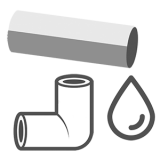| » » » |
Que recherchez-vous ?
How to Properly Eliminate Turbidity in Well Water for the Home?
Turbidity is the presence of suspended particles and sediment in water, and it is a common problem for those who rely on well water for their household needs. Although turbidity does not always pose an immediate health risk, it can affect the quality, taste and appearance of water, making it undesirable for drinking and daily use. In this article, we'll dive into the importance of effectively removing turbidity from well water and explore various methods and techniques that homeowners can use to ensure a clean and safe water supply. By understanding the causes of turbidity, choosing appropriate filtration systems, and implementing good maintenance practices, you can enjoy the benefits of clear, pristine water straight from your well.
How important is it to remove turbidity from well water?
Turbidity, in simple terms, refers to turbidity or cloudiness of water caused by suspended particles. Although it may not seem like a big deal at first, removing turbidity from well water is essential to ensure its quality and safety.
The Impact of Turbidity on Well Water Quality
Turbidity can affect the taste, odor and appearance of well water. No one wants to drink water that looks like a murky swamp or tastes like a mouth full of sediment. In addition to being unappetizing, high levels of turbidity can also indicate the presence of harmful contaminants, making it essential to resolve this problem quickly.
Health and Environmental Risks Linked to Turbidity
Turbidity not only affects water quality, but it also poses health and environmental risks. Suspended particles can harbor bacteria, viruses and parasites, which can cause gastrointestinal illness when ingested. Additionally, as turbidity increases, it reduces the penetration of sunlight into water bodies, impacting aquatic life and disrupting ecosystems.
Assessing the Source of Turbidity: Identifying Causes and Implications
To effectively combat turbidity, it is important to understand its source by carrying out a water analysis in a laboratory. There are two main categories of causes of turbidity: natural and man-made.
Natural Causes of Turbidity in Well Water
Natural sources of turbidity include soil erosion, decomposition of organic matter, and geological formations. Torrential rains, flooding or changes in the water table can aggravate these natural causes, leading to increased turbidity in well water.
Human Activities Leading to Turbidity in Well Water
Human activities such as construction, mining, agriculture, and wastewater discharge can introduce sediment and pollutants into water bodies. Inadequate land management practices, ineffective erosion control, and ineffective waste treatment contribute to high levels of turbidity in well water.
How to choose the right filtration method to eliminate turbidity?
Now that we understand the sources of turbidity, let's explore some techniques for removing it from well water.
Sedimentation: A Traditional Approach to Turbidity Removal
Sedimentation involves letting water sit undisturbed in a tank or pond, allowing heavy particles to settle to the bottom. This method is effective for larger particles, but may not remove finer turbidity.
Coagulation and Flocculation: Improving Filtration Efficiency
Coagulation involves adding chemicals that neutralize the electrical charges of suspended particles, causing them to stick together. Flocculation then promotes the formation of larger flakes that can be more easily separated from the water. This technique significantly improves the efficiency of turbidity removal.
Filtration Systems: Sand, Carbon and Multiple Media Filters
Filtration systems are commonly used to remove turbidity from water. Sand, carbon, and multi-media filters use different layers of media to trap and remove suspended particles. These filtration methods are effective for a wide range of turbidity levels and can be customized based on specific water quality needs.
Pretreatment Measures: Preparing Well Water for Effective Filtration
Before applying filtration methods, pretreatment measures can improve the efficiency of turbidity removal.
pH Adjustment and Disinfection: Optimization of the Filtration Process
Adjusting water pH to optimal levels can improve coagulation and flocculation processes, thereby improving the overall efficiency of the filtration system. Additionally, disinfection methods such as chlorination or UV treatment help eliminate any remaining bacteria or viruses, ensuring the safety of the filtered water.
Removing turbidity from well water is essential to maintaining its quality, safety and attractiveness. By understanding the causes, choosing appropriate filtration methods, and implementing pretreatment measures, you can ensure that the water flowing from your faucets is crystal clear and free of harmful contaminants.
Installation of an Appropriate Filtration System
So, you've decided to tackle the troubled waters of turbidity in your well water. Well done ! But before diving headfirst into the world of filtration systems, there are a few crucial factors to consider. First, assess throughput and capacity requirements.
Assessment of Throughput and Capacity Needs
When it comes to choosing a filtration system, you need to make sure it can handle the flow rate and capacity of your well water. Think of it like choosing the right size umbrella for a rainy day - you don't want it to be too small or you'll get soaked, and you definitely don't need one as big as a marquee circus.
Note how much water you typically use and consider any future increases in demand. This will help you determine the appropriate flow rate and capacity your filtration system should handle.
Selecting the Right Filtration Media and Materials
Now that you have defined your flow and capacity needs, it's time to explore the world of filtration media and materials. Think of this step as selecting the perfect outfit - you want something that looks great and gets the job done.
There are various filtration media options, such as activated carbon, sand or ceramic. Each has its own advantages and disadvantages, so consider factors such as filtration efficiency, cost and maintenance requirements.
Choice between Automatic and Manual Filtration Systems
Now, let's talk about convenience. Are you someone who prefers everything to be automatic, like a self-driving car, or do you like to get your hands dirty, like a child playing in the mud? This is an important consideration when choosing between automatic and manual filtration systems.
Automatic systems come with sophisticated features like timers and sensors that do the work for you, making your life easier than tossing a wet towel into the laundry basket. Manual systems, on the other hand, require more active involvement, but can be more economical. It's about finding the right balance between laziness and frugality - a delicate art indeed.
Maintenance and Monitoring of treatment systems
Ensuring the Longevity and Effectiveness of Turbidity Elimination Systems
Congratulations on installing your filtration system! applause But don't think your work is done. Like an unruly pet, these systems require regular maintenance and monitoring to keep them in tip-top condition.
Regular Cleaning and Backwashing of Filters
No one wants a filter as clogged as a teenager's pores or as dirty as a child after a finger painting session. Regular cleaning and backwashing is essential to keep your filters clean and functioning optimally. So grab your cleaning supplies and obsess over indoor cleanliness – it's time to scrub those filters.
Monitoring Turbidity Levels and System Performance
Just like monitoring the stock market or keeping an eye on your sleek fitness tracker, it's important to monitor turbidity levels and filtration system performance. This ensures that everything is working properly and effectively removes those pesky particles from your water. If things go wrong, you'll be able to quickly intervene and take necessary action, like a superhero coming to the rescue.
Removing turbidity from well water is essential to maintaining the quality, safety and usefulness of this valuable water source. By identifying sources of turbidity, choosing the right filtration methods, and implementing regular maintenance and monitoring practices, homeowners can ensure their well water remains free of suspended particles and sediment. With clean, safe water available to them, individuals can have peace of mind knowing that their drinking water and daily water needs meet the highest quality standards. Remember that proper turbidity removal is not only essential for health, but also for the overall satisfaction and well-being of those who use well water in their homes.





























































